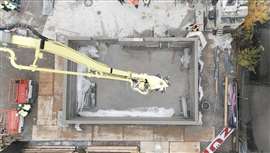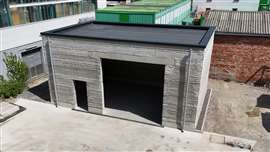Read this article in Français Deutsch Italiano Português Español
Züblin constructs ‘world first’ load-bearing concrete walls with 3D printer
07 May 2024
Züblin, a Germany-based construction engineering company and subsidiary of Putzmeister and Strabag, announced it constructed a building from a single 3D print with load-bearing concrete walls; a ‘world first’ according to the company.
 Züblin uses a Putzmeister 3D printer to construct a warehouse for Strabag in Germany (Image: Putzmeister)
Züblin uses a Putzmeister 3D printer to construct a warehouse for Strabag in Germany (Image: Putzmeister)
The building is Strabag Baumaschinentechnik International’s newest warehouse in Stuttgart, Germany, and its construction will both create a new facility for Strabag while testing Züblin’s 3D printing capabilities and processes.
Using Putzmeister’s KARLOS mobile concrete printer, the machine’s mast boom has a 26-metre reach. It’s extensive span, Züblin said, allows the application of “concrete in several layers precisely on the basis of a predefined and digital blueprint via a special print head.”
Alexander Kuhn, head of technical services construction and technology at Züblin, said, “The basis of the KARLOS printing process is an intelligent truck-mounted concrete pump, whose telescopic arm can move and deliver concrete automatically along predefined paths in three-dimensional space using a specially developed print head.
Until now, the challenges of 3D concrete printing have mainly been the lack of scalability of the technology for large-scale projects. “Printing has mainly been done with so-called portal printers, which are limited to the production of smaller buildings,” said Züblin.
The company added that KARLOS allows more flexibility and range, which provides the potential for scalability – even for large-scale projects.
“The economic advantage of this ‘world-first’ technology, compared to other concrete or mortar printing technologies like using a gantry printer, lies in its flexibility and range as well as in the ability of printing load-bearing solid walls in one step that comply with relevant standards and regulations,” added Kuhn.
 The finished Strabag warehouse after KARLOS, a Putzmeister 3D printer, delivered the concrete paste. (Image: Putzmeister)
The finished Strabag warehouse after KARLOS, a Putzmeister 3D printer, delivered the concrete paste. (Image: Putzmeister)
Delivering cementitious paste in a rectangular method, much like the form of a brick (as opposed to a rounded edge like most 3D concrete printers), the squared walls are able to support the weight of the building.
“Stacked on top of each other, the cuboid cross-sections of each layer result in unreinforced but load-bearing concrete walls that do not require any further work steps,” added Kuhn, noting “the material used in this process is plain concrete, C30/37, in accordance to EC2.”
Using every aspect of automation
The project was not without its challenges, however. Kuhn added that a multifaceted and dynamic plan helped pull the structure together.
“Major challenges to getting load-bearing capability are to be found in the combination of concrete technology and process technology,” he acknowledged. “On the one hand, concrete recipes must take into account an early-stage strength as well as an adequate consistency regarding the pumping process, whereas on the other hand, the pumping boom must be exactly controlled with regards to positioning and movement speed.
“Furthermore,” he continued, “controlling and monitoring the concrete shrinking behaviour and its strength gain are crucial in order to avoid cracks within each layer and between adjacent layers which could result either in the collapse of the freshly printed wall section prior to and/or in (partially) the loss of mechanical properties of the wall after reaching the final concrete strength.”
Combined with electrification, digital planning, and use of a BIM model on this project, Züblin said it’s hoping to develop novel construction methods for the future.
“The combination of the production steps from the digital planning of the BIM model (Building Information Modelling) to the implementation by 3D printer revolutionizes the processes in construction. Work processes are significantly streamlined and accelerated by automation,” said the company.
“In addition to the complete elimination of formwork work, the economic and ecological advantages of the method include the production of solid wall cross-sections in a single operation and the use of CO2-reduced concretes.
“By using only green electricity for the all-electric machine and using CO2-reduced concretes, Züblin and Putzmeister are making an important contribution to making building construction more sustainable in the future.”
STAY CONNECTED


Receive the information you need when you need it through our world-leading magazines, newsletters and daily briefings.
CONNECT WITH THE TEAM











